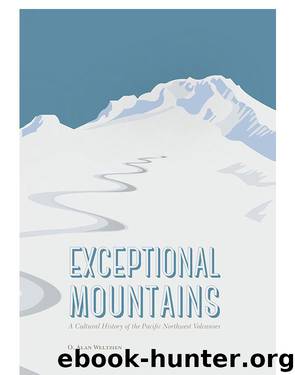Exceptional Mountains by O. Alan Weltzien

Author:O. Alan Weltzien [Weltzien, O. Alan]
Language: eng
Format: epub
Tags: HIS036110 History / United States / State & Local / Pacific Northwest (or, Wa)
ISBN: 9780803290402
Publisher: UNP - Nebraska
Published: 2016-05-24T16:00:00+00:00
5
Wilderness and Volcanoes
A small share of the American people have an overpowering longing to retire periodically from the encompassing clutch of mechanistic civilization. . . . To them, the enjoyment of solitude, complete independence, and the beauty of undefiled panoramas is absolutely essential to happiness.
—Robert Marshall
In the United States, mountains have proven a primary domain for our changing understanding and valuation of wilderness, in part because mountains comprised our first wilderness areas. Mountains possess a psychological and symbolic remoteness as realms removed from usual human affairs, even if occasional cities or towns spread close to particular peaks. Iconic sites above and beyond human settlement, mountains are historically associated with deities and serve as threshold for divine communication if not epiphany. Late Northwest composer Alan Hovhaness, who wrote symphonies dedicated to two of Washington’s five volcanoes (Symphony #50, Mount St. Helens; and Symphony #66, Hymn to Glacier Peak), endorsed this archetypal view: “Mountains are symbols, like pyramids, of man’s attempt to know God” (Notes to “Mysterious Mountain,” 1955). Hovhaness defines the familiar motive for climbing as a fundamental desire for physical places far above the mundane. The sociability of climbing in no way lessens (though it might obscure) the old value of personal transformation, or the appeal of volcanoes or other mountains as pilgrimage sites.
Wilderness and remoteness overlap considerably as human constructs in the Northwest, as the region’s volcanoes evidence. Mount Rainier was first set aside in the Pacific Forest Reserve in 1893; Mount Hood, in the Bull Run Forest Reserve in 1892. The Forest Reserve Act of 1891 was not designed solely to set aside acreage “for the protection of timber and watersheds.” Rather, scenic values and preservation of spectacular landscapes were primary criteria years before either the USFS (1905) or NPS (1916) came into being. As President Benjamin Harrison’s secretary of the interior, John Noble, argued in a letter to the President on March 25, 1891, reserves should include areas “of great interest to our people because of their natural beauty, or remarkable features.”1 The impulse to set aside public lands in the fin-de-siècle western United States arose, in part, out of deepening appreciation of mountainscapes inspired by landscape painting and photography. Certainly, the Pacific Northwest’s most exceptional mountains provide a fascinating case history of evolving ideas about wilderness because of their status as “reservoirs of the primitive.”2
In the Northwest the notion of “wilderness volcano” developed as a result of urban growth: those snowpeaks farthest from cities or their viewsheds epitomized remoteness. As hinterland they rise in the “back” range, not the front, farther from the collective human gaze—and trailheads. These include Washington’s Glacier Peak and Oregon’s Mount Jefferson—which ironically rises right along the Cascade Crest. But no highway cuts close to it. Such judgments have abided through the past two centuries. For example, in The Northwest Coast (1857), pioneering ethnographer and diarist James G. Swan twice omits mention of Glacier Peak among Washington Territory’s five volcanoes. It existed outside his purview and that of the territory’s young, seaside towns.
Download
This site does not store any files on its server. We only index and link to content provided by other sites. Please contact the content providers to delete copyright contents if any and email us, we'll remove relevant links or contents immediately.
The Lonely City by Olivia Laing(4120)
Animal Frequency by Melissa Alvarez(3755)
All Creatures Great and Small by James Herriot(3516)
Walking by Henry David Thoreau(3234)
Exit West by Mohsin Hamid(3183)
Origin Story: A Big History of Everything by David Christian(3139)
COSMOS by Carl Sagan(2950)
How to Read Water: Clues and Patterns from Puddles to the Sea (Natural Navigation) by Tristan Gooley(2855)
Hedgerow by John Wright(2776)
The Inner Life of Animals by Peter Wohlleben(2766)
Origin Story by David Christian(2683)
How to Read Nature by Tristan Gooley(2665)
Project Animal Farm: An Accidental Journey into the Secret World of Farming and the Truth About Our Food by Sonia Faruqi(2661)
How to Do Nothing by Jenny Odell(2645)
A Forest Journey by John Perlin(2587)
Water by Ian Miller(2584)
The Plant Messiah by Carlos Magdalena(2453)
A Wilder Time by William E. Glassley(2363)
Forests: A Very Short Introduction by Jaboury Ghazoul(2335)
